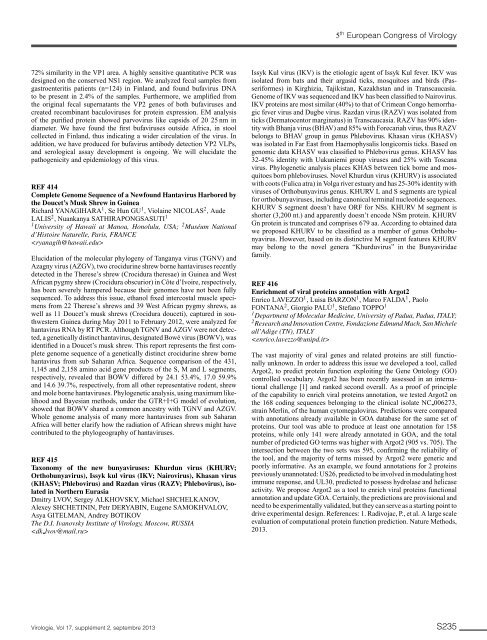rologie i - European Congress of Virology
rologie i - European Congress of Virology
rologie i - European Congress of Virology
Create successful ePaper yourself
Turn your PDF publications into a flip-book with our unique Google optimized e-Paper software.
5 th <strong>European</strong> <strong>Congress</strong> <strong>of</strong> <strong>Virology</strong>72% similarity in the VP1 area. A highly sensitive quantitative PCR wasdesigned on the conserved NS1 region. We analyzed fecal samples fromgastroenteritis patients (n=124) in Finland, and found bufavirus DNAto be present in 2.4% <strong>of</strong> the samples. Furthermore, we amplified fromthe original fecal supernatants the VP2 genes <strong>of</strong> both bufaviruses andcreated recombinant baculoviruses for protein expression. EM analysis<strong>of</strong> the purified protein showed parvovirus like capsids <strong>of</strong> 20 25 nm indiameter. We have found the first bufaviruses outside Africa, in stoolcollected in Finland, thus indicating a wider circulation <strong>of</strong> the virus. Inaddition, we have produced for bufavirus antibody detection VP2 VLPs,and serological assay development is ongoing. We will elucidate thepathogenicity and epidemiology <strong>of</strong> this virus.REF 414Complete Genome Sequence <strong>of</strong> a Newfound Hantavirus Harbored bythe Doucet’s Musk Shrew in GuineaRichard YANAGIHARA 1 , Se Hun GU 1 , Violaine NICOLAS 2 , AudeLALIS 2 , Nuankanya SATHIRAPONGSASUTI 11 University <strong>of</strong> Hawaii at Manoa, Honolulu, USA; 2 Muséum Nationald’Histoire Naturelle, Paris, FRANCEElucidation <strong>of</strong> the molecular phylogeny <strong>of</strong> Tanganya virus (TGNV) andAzagny virus (AZGV), two crocidurine shrew borne hantaviruses recentlydetected in the Therese’s shrew (Crocidura theresae) in Guinea and WestAfrican pygmy shrew (Crocidura obscurior) in Côte d’Ivoire, respectively,has been severely hampered because their genomes have not been fullysequenced. To address this issue, ethanol fixed intercostal muscle specimensfrom 22 Therese’s shrews and 39 West African pygmy shrews, aswell as 11 Doucet’s musk shrews (Crocidura douceti), captured in southwesternGuinea during May 2011 to February 2012, were analyzed forhantavirus RNA by RT PCR. Although TGNV and AZGV were not detected,a genetically distinct hantavirus, designated Bowé virus (BOWV), wasidentified in a Doucet’s musk shrew. This report represents the first completegenome sequence <strong>of</strong> a genetically distinct crocidurine shrew bornehantavirus from sub Saharan Africa. Sequence comparison <strong>of</strong> the 431,1,145 and 2,158 amino acid gene products <strong>of</strong> the S, M and L segments,respectively, revealed that BOWV differed by 24.1 53.4%, 17.0 59.9%and 14.6 39.7%, respectively, from all other representative rodent, shrewand mole borne hantaviruses. Phylogenetic analysis, using maximum likelihoodand Bayesian methods, under the GTR+I+G model <strong>of</strong> evolution,showed that BOWV shared a common ancestry with TGNV and AZGV.Whole genome analysis <strong>of</strong> many more hantaviruses from sub SaharanAfrica will better clarify how the radiation <strong>of</strong> African shrews might havecontributed to the phylogeography <strong>of</strong> hantaviruses.REF 415Taxonomy <strong>of</strong> the new bunyaviruses: Khurdun virus (KHURV;Orthobunyavirus), Issyk kul virus (IKV; Nairovirus), Khasan virus(KHASV; Phlebovirus) and Razdan virus (RAZV; Phlebovirus), isolatedin Northern EurasiaDmitry LVOV, Sergey ALKHOVSKY, Michael SHCHELKANOV,Alexey SHCHETININ, Petr DERYABIN, Eugene SAMOKHVALOV,Asya GITELMAN, Andrey BOTIKOVThe D.I. Ivanovsky Institute <strong>of</strong> <strong>Virology</strong>, Moscow, RUSSIAIssyk Kul virus (IKV) is the etiologic agent <strong>of</strong> Issyk Kul fever. IKV wasisolated from bats and their argasid ticks, mosquitoes and birds (Passeriformes)in Kirghizia, Tajikistan, Kazakhstan and in Transcaucasia.Genome <strong>of</strong> IKV was sequenced and IKV has been classified to Nairovirus.IKV proteins are most similar (40%) to that <strong>of</strong> Crimean Congo hemorrhagicfever virus and Dugbe virus. Razdan virus (RAZV) was isolated fromticks (Dermatocentor marginatus) in Transcaucasia. RAZV has 90% identitywith Bhanja virus (BHAV) and 85% with Forecariah virus, thus RAZVbelongs to BHAV group in genus Phlebovirus. Khasan virus (KHASV)was isolated in Far East from Haemophysalis longicornis ticks. Based ongenomic data KHASV was classified to Phlebovirus genus. KHASV has32-45% identity with Uukuniemi group viruses and 25% with Toscanavirus. Phylogenetic analysis places KHAS between tick borne and mosquitoesborn phleboviruses. Novel Khurdun virus (KHURV) is associatedwith coots (Fulica atra) in Volga river estuary and has 25-30% identity withviruses <strong>of</strong> Orthobunyavirus genus. KHURV L and S segments are typicalfor orthobunyaviruses, including canonical terminal nucleotide sequences.KHURV S segment doesn’t have ORF for NSs. KHURV M segment isshorter (3,200 nt.) and apparently doesn’t encode NSm protein. KHURVGn protein is truncated and comprises 679 aa. According to obtained datawe proposed KHURV to be classified as a member <strong>of</strong> genus Orthobunyavirus.However, based on its distinctive M segment features KHURVmay belong to the novel genera “Khurduvirus” in the Bunyaviridaefamily.REF 416Enrichment <strong>of</strong> viral proteins annotation with Argot2Enrico LAVEZZO 1 , Luisa BARZON 1 , Marco FALDA 1 , PaoloFONTANA 2 , Giorgio PALÙ 1 , Stefano TOPPO 11 Department <strong>of</strong> Molecular Medicine, University <strong>of</strong> Padua, Padua, ITALY;2 Research and Innovation Centre, Fondazione Edmund Mach, San Micheleall’Adige (TN), ITALYThe vast majority <strong>of</strong> viral genes and related proteins are still functionallyunknown. In order to address this issue we developed a tool, calledArgot2, to predict protein function exploiting the Gene Ontology (GO)controlled vocabulary. Argot2 has been recently assessed in an internationalchallenge [1] and ranked second overall. As a pro<strong>of</strong> <strong>of</strong> principle<strong>of</strong> the capability to enrich viral proteins annotation, we tested Argot2 onthe 168 coding sequences belonging to the clinical isolate NC 006273,strain Merlin, <strong>of</strong> the human cytomegalovirus. Predictions were comparedwith annotations already available in GOA database for the same set <strong>of</strong>proteins. Our tool was able to produce at least one annotation for 158proteins, while only 141 were already annotated in GOA, and the totalnumber <strong>of</strong> predicted GO terms was higher with Argot2 (905 vs. 705). Theintersection between the two sets was 595, confirming the reliability <strong>of</strong>the tool, and the majority <strong>of</strong> terms missed by Argot2 were generic andpoorly informative. As an example, we found annotations for 2 proteinspreviously unannotated: US26, predicted to be involved in modulating hostimmune response, and UL30, predicted to possess hydrolase and helicaseactivity. We propose Argot2 as a tool to enrich viral proteins functionalannotation and update GOA. Certainly, the predictions are provisional andneed to be experimentally validated, but they can serve as a starting point todrive experimental design. References: 1. Radivojac, P., et al. A large scaleevaluation <strong>of</strong> computational protein function prediction. Nature Methods,2013.Vi<strong>rologie</strong>, Vol 17, supplément 2, septembre 2013S235


